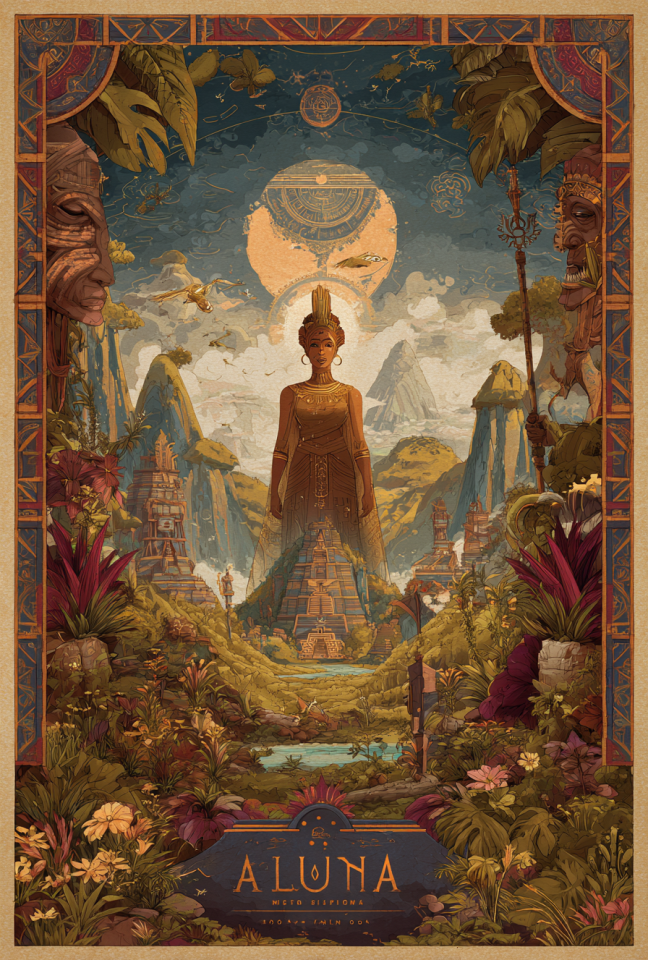Aluna is the breath behind reality — a Divine Realm not of matter, but of conscious intention from which all form, motion, and light first emerged. Rooted in the spiritual cosmology of the Muisca and their ancestral kin, Aluna is not a place one travels to, but one returns through, as every soul is a ripple of its thought. It is the sacred origin of memory, balance, and inner knowing — not silent, but resonant, vibrating just beneath the surface of all being. Though once accessed by the ritual minds of the Muisca spiritual elite, the descent of conquest severed the sacred transmissions, and now Aluna is sealed — unreachable to mortals, yet eternally aware.
Landscape and Essence
Aluna does not unfold in spatial terrain, but in layers of perception. It appears to those permitted entry as a vast, luminous sea — not of water, but of interwoven light and thought. Within it, symbols move as creatures, and dreams crystallize into passing forms. Threads of golden mist connect unseen ideas, and reflections ripple not from surfaces, but from truths. There is no gravity here, only resonance — what draws near is what aligns. Some report great spheres of light pulsing like hearts, or soundless music vibrating through fields of intention. Others say the landscape only emerges when a question is held long enough in stillness.
Inhabitants
Aluna is governed by Chiminigagua the primordial essence of radiant thought, who manifests not in body, but in gesture and pulse. Around this presence exist luminous beings — not gods in the conventional sense, but intelligences of balance, memory, and design. They appear only when needed: architects of celestial cycles, whisperers of right action, watchers of cause before consequence. Ancestors of great inner purity are said to have merged with Aluna rather than passed on — they no longer act, but ripple. There are no animals, no cities, no storms — only the quiet motion of sacred consciousness becoming form.
Cultural Significance
To the Muisca, Aluna was not mythology — it was cosmological fact. It underpinned ritual, agriculture, law, and language. Spiritual leaders, the iraka, trained not to rule but to commune with Aluna’s hidden layers, listening for the thoughts behind events. Offerings of coca leaves, carved stones, and sacred gold figures were not for the gods — they were signals messages transmitted into Aluna to maintain balance. Temples were oriented not to sky alone, but to memory — the collective, timeless truth stored in this divine substrate. After the arrival of colonizers and the suppression of native rites, the practice of communion faded, and Aluna receded — not out of anger, but to preserve its own clarity.
Role in the Divine Realm
Aluna is the foundation beneath all other realms — the first echo of divine mind before action, before creation, before narrative. It does not govern or intervene; it remembers and holds. From it, deities draw design. Into it, fallen balance dissolves. It is neither paradise nor punishment, but origin — the luminous breath beneath the river of time. Unlike realms of reward, judgment, or conflict, Aluna offers no throne and holds no war — only the quiet unfolding of all things.
Interactions with Other Realms
In ancient times, Aluna was accessible to trained seers, ritual singers, and elders who entered stillness so complete it reflected the realm itself. Certain lakes, caves, and sacred peaks in the Andes were known as points of thinning — places where Aluna’s breath stirred the world. But as colonial violence, forced conversion, and cultural fragmentation took root, those who remembered the way either hid or perished. The Veil now covers Aluna completely, and no mortal voice can pass into it without divine invitation. Still, dreams that bring clarity, unspoken knowings, and certain patterns in nature are said to echo from Aluna’s pulse.
















